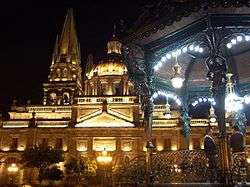Romería
A romería (Spanish) or romaria (Portuguese) is a type of yearly, short distance Roman Catholic religious pilgrimage practiced in the Iberian Peninsula and countries formerly colonized by Spain and Portugal. The term comes from romero/romeiro, meaning a person travelling to Rome. The travelling can be done in cars, floats, on horseback or on foot, and its destination is a sanctuary or hermitage consecrated to a religious figure honored in that day's feast. Besides attending religious services and processions, the pilgrims may also engage in social events like singing, feasting and dancing.
Background
One of the most famous examples of a pilgrimage is that of Nuestra Señora del Rocío, in which the faithful move to the Sanctuary of the Virgen del Rocío in the village of the Rocío, in Almonte, Huelva. The Romeria of Sant John of the Mountain, celebrated in Miranda de Ebro, is the second most important romeria in Spain behind El Rocío with more than 25,000 romeros.
Another one of the most representative examples is the Romería de la Virgen de la Cabeza (Andújar, Jaén), which is considered the oldest pilgrimages of Spain, and consists of the displacement of the travellers coming from all over the country to the Sanctuary of the Virgen de la Cabeza, through 33 km of Andújar, in the heart of Sierra de Andujar natural park. This celebration is held the last Sunday of April and is considered of national tourist interest.
The Romería de la Virgin de Navahonda, celebrated in spring in the Madrilenian municipality of Robledo de Chavela is representative of this tradition.
There are also pilgrimages in the Canary Islands. An example is La Romería de Santiago Apostol, in Gáldar. Instead of focusing on Jesus, the floats usually praise the Virgin Mary with pictures and statues.
The New World

In Mexico, pilgrims walk to the Our Lady of Zapopan, which this considered the third most important peregrination in the country, after the one of the Virgin of Guadalupe, and the Virgin of San Juan de los Lagos. The Pilgrimage of the Virgin of Zapopan consists of a route 8 km in length, from the Guadalajara Cathedral to the Basilica of Our Lady of Zapopan. It is made every 12 October, and figure of the virgin goes accompanied by more than 3,000,000 people.
In Costa Rica, it is traditional to make a pilgrimage to Cartago on 2 August to make requests and give thanks to the Virgen de los Ángeles (the Lady of the Angels), nicknamed la Negrita due to the dark green color of the statue representing her; the statue located inside the Basilica of Our Lady of the Angels. People all over the country and even other Central American countries participate on foot or horseback. In 2009, due to AH1N1 spreading risks, it was officially cancelled, but the statue was taken on a tour to cities instead.
External links
| Wikimedia Commons has media related to Pilgrimage. |